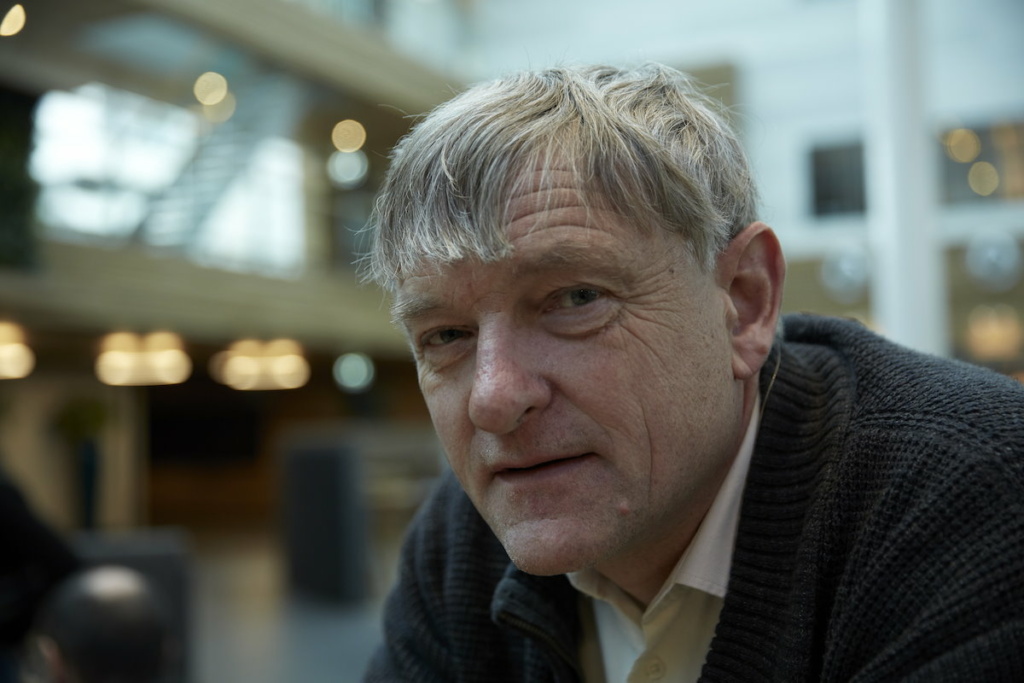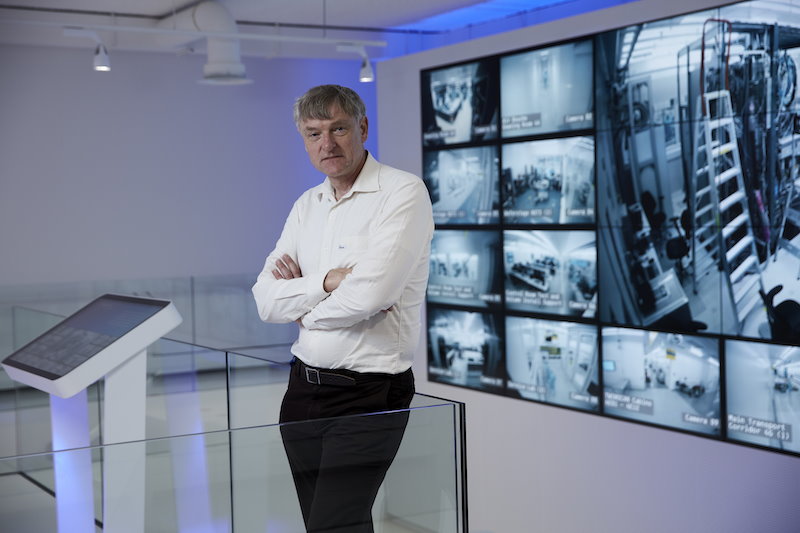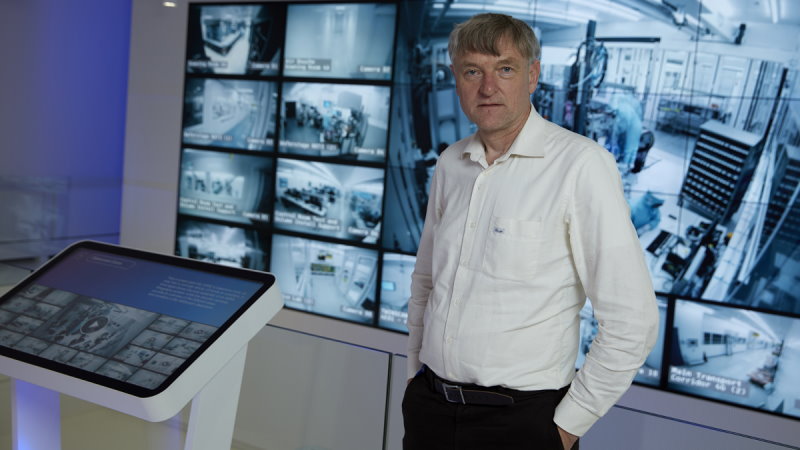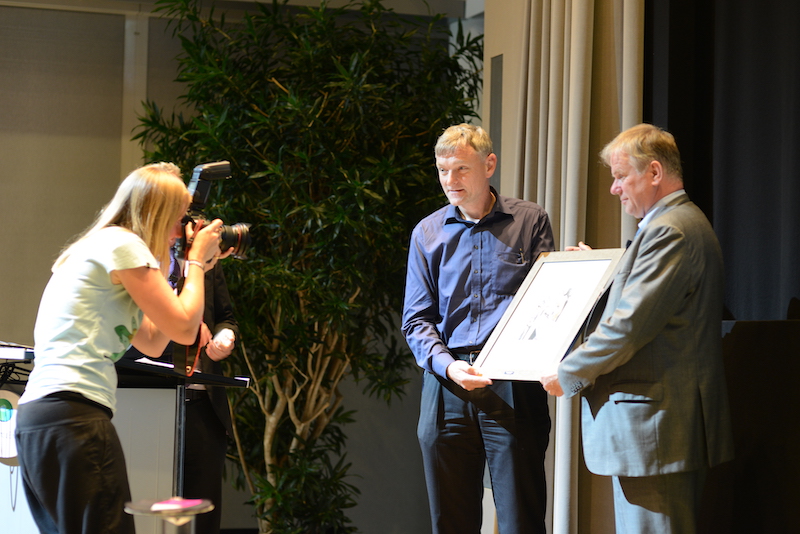
Erik Loopstra (1957-2024), unrelenting motor of ASML’s machine development
For many years, Erik Loopstra was one of the driving forces behind ASML’s engineering in Veldhoven. Many (former) colleagues saw him as a motor of machine development at the lithography company until he went to partner Zeiss Semiconductor Manufacturing Technology (SMT) in 2018 to give a push to the mechatronics competence there. Whereas Martin van den Brink, who retired early this year, was in frequent contact with customers, connecting market and technology, Loopstra was one of the boosters within the company.
The whole of high tech knew Loopstra’s reputation, but for the outside world, he remained invisible for a long time. That suited him like a glove. “He felt comfortable with the technical specialists,” says Wilbert Kohler, who experienced him closely at Zeiss in recent years. “Often people at his level don’t have that anymore because they’ve lost touch at some point when they’ve been ‘up high’ for too long.” According to Kohler, Loopstra was an example of someone who has risen through the ranks but has remained very approachable, which helped find good solutions. “Because, at the end of the day, it’s all about teamwork.”
At times when he was thrust into the spotlight, Loopstra felt visibly uncomfortable. Like in the promotional tour surrounding the nomination for the European Inventor Award’s Popular Prize in 2018, with which he caught the public eye for the first time. He endured these moments idly. “We joked with each other that a life as a supermodel is much more difficult than that of an engineer,” says Vadim Banine, who received the award with him. “We hadn’t realized how much time it would take to take a few good pictures and record a video.” Through the promotional tour they made with their partners, Banine says he also got to know Loopstra from another side, “that of caring husband.”
No-nonsense
“Erik was an outstanding systems engineer who made very substantial contributions to many of ASML’s key technologies,” reads a press release from ASML, which rarely announces when employees retire or pass away. Head of technology Jos Benschop: “Few people have contributed as much to ASML’s success as Erik. His curiosity, his drive and his ability to turn insights into practical breakthroughs made him one of our best machine builders ever. He was an inspiration to many of us and will be greatly missed.”
“Erik had an excellent sense of understanding where challenges were keeping the company busy and then got involved in these projects personally,” adds Markus Knuefermann, head of product design mechanics and verification at Zeiss SMT. “The focus with which he pursued these issues was impressing. His aim was always to solve them as quickly and effectively as possible. When Erik got stuck with a problem, there was hardly anything else for him.”
Like Van den Brink, Loopstra was a representative of ASML’s no-nonsense development culture. On his desk, he had a miniature version of the Fairytale Tree from the Efteling amusement park. He would point to it whenever there was too much dreaming and hoping in a project, or when people in discussions were unable to sufficiently substantiate their views. “Erik could always point this out in great detail,” says one of the persons on the receiving end. “If you weren’t sure about something, or couldn’t substantiate it well, he could be very confrontational.”
Many mention the sayings he used, such as “Help is only help if it helps” and “Many hands make light work hard.” His “Don’t put off until tomorrow what you can get someone else to do today” is somewhat of an ASML adage.
“Erik was a brilliant technician with great insight and creativity,” says Hans Sluiters. As an employee of the engineering firm CCM, Sluiters met Loopstra in the 1990s. “Besides Van den Brink, he was the only one who understood all the machine modules and their interfaces. He was extremely focused, never losing sight of the goal, which was that the machine had to go to the customer in more or less working order and as quickly as possible.” On Loopstra’s way of challenging: “The sissies and bruised egos said he imitated Brink’s style, but in my opinion, that’s not true; he was blunt and intimidating but absolutely authentic.”
Broad technician
Erik Loopstra came from an originally Frisian family and grew up in a small village in the province of North Holland. He graduated in the early 1980s in professor Dedde de Jong’s Fine Mechanical Engineering group in Delft. He went to work at Philips in Dordrecht and then in Heerlen at the just-completed production line of Philips LCD Cells & Modules, which later moved to the Natlab site. In 1991, he transferred to ASML.
At ASML, Loopstra quickly developed into a broad technician who could talk about control engineering and optics as well. “His ability to learn new things was amazing,” recalls Vadim Banine, who worked with him for years on EUV lithography. “Erik wasn’t a physicist. At first, he could use completely wrong units in a physics problem, but after two weeks, he put a specialized physicist in his place with his acquired knowledge.”
Martin van den Brink was impressed by Loopstra’s insights. “What amazed me, for example, was that he knew exactly what the thread of a bike pedal was and why.” Van den Brink had asked the same question to as many as thirty mechanical engineers. “Also to the brightest of the bright. Erik was the only one who could tell me.”
Systems thinker
Loopstra’s ability to learn new things was regarded with amazement by other colleagues. Everything he worked on he wanted to get to the bottom of. This trait, along with his theoretical and practical talent, made him develop into a leading system architect. “Erik was extraordinarily driven and gifted at setting up a good system architecture,” says colleague Hans Vermeulen. Employed by Philips’ Center for Manufacturing Technology (CFT), he collaborated with Loopstra in the early days of EUV on the architecture of the first EUV alpha demo tool. “Initially, he worked somewhat haphazardly but also extremely critically, with an eye for detail.”
During his inaugural address in 2016, part-time professor Vermeulen called Loopstra one of his great examples. “No challenge was too big for him. The speed of his thinking and switching, his extensive systems knowledge, his agility to zoom in and out and his creativity made him inspiring to me, a role model."
Jan van Eijk, who got to know the young Loopstra as a student supervisor in De Jong’s group in Delft, also sees him primarily as a systems thinker. “Erik strongly adhered to the systems approach. He was very broadly engaged in all facets of engineering and science. Slowly, he managed to surround himself with key engineers who knew how to make the right interpretation in the different areas.”
In his early years at ASML, Loopstra became part of the PAS 5500 team, where he was instrumental in getting the completely new modular machine design ready for production. With the PAS 5500, the Veldhoven-based company really put itself on the semicon map in 1993. Thereafter, Loopstra was involved in almost all significant machine developments, including the evolution of the PAS 5500 to a step-and-scan system in the second half of the 1990s, the introduction of the Twinscan with two wafer stages after the turn of the millennium, the subsequent upgrade to immersion and the introduction of EUV. Banine: “All major ASML products bear Erik’s stamp.”

Unrelenting
Philips CFT was still doing preliminary development for ASML in the late 1990s. Among other things, it worked on the step-and-scan principle for the PAS 5500. Loopstra participated in these projects from ASML. He increasingly took a leading role and worked closely with Jan van Eijk and Ton Peijnenburg. “Every week, for months on end, we romped with Martin and Erik about the specs,” Van Eijk recalls.
As an illustrative example, Van Eijk mentions the discussion about the maximum acceleration of the reticle stage (which moves the heavy mask opposite to the scanning wafer stage). “In the first scanner, we achieved 30 m/s2. For the Twinscan, we at CFT wanted to go to 50 m/s2, but Erik called that a chicken spec. That was for sissies. He wanted to go to 80 m/s2. In the end, it remained 50 m/s2 for the first generation, but Erik was unrelenting and now, we’re talking about 200 m/s2.”
With the Twinscan, Loopstra contributed to the development of a system with balancing masses and the long-stroke-with-short-stroke stages with laser interferometry. For the EUV alpha demo tool, planar motors and technology in vacuum were the major challenges. For high-NA, it was the very fast stages and the large, scanning optics. Additionally for high-NA, very extensive metrology had to be built to measure the multilayer mirrors at the picometer level. As one of the leaders in the development, Loopstra helped shape it. “I work on the future,” he said in a 2009 interview with the Dutch newspaper Eindhovens Dagblad, “on machines that don’t exist today but might in a few years.”
Complete dedication
As someone with the natural drive to push boundaries, Loopstra was used primarily during the conceptual phase of new systems. “As a creative mind, he was less useful at the later stage of development,” says Van Eijk. “At that point, his propensity to come up with better alternatives got in the way of realizing the chosen solution.”
Loopstra has been most honored for his pioneering work on EUV. For this, he and Vadim Banine received the European Inventor Award’s Popular Prize in 2018. Banine comments, “Erik worked on a product with complete dedication. Nothing was unsolvable. He went through every wall. It was a mix of ingenuity, tremendous drive, strong focus and total commitment.”
“Erik has played a crucial role in shaping the mechanical and mechatronic concepts of the alpha demo tool optics,” says Peter Kuerz, head of field of business high-NA EUV lithography at Zeiss SMT. Kuerz and Loopstra were part of the team that started the first major EUV development 25 years ago. “Later on, Erik’s expertise and judgement were instrumental in designing the illumination system and projection optics for EUV lithography” adds Kuerz.
One of the biggest challenges in developing high-NA EUV lithography was the mirror metrology. “An area where we entered uncharted territory,” notes Kuerz. “Erik’s visionary thinking led to an entirely new concept for measuring EUV mirrors with picometer precision. He had a unique ability to invent entirely new concepts and instill confidence in our team that we could achieve anything together. He was an excellent problem solver with an immense power of imagination.”
Looking back, Van Eijk views the development of the Twinscan with two wafer stages as Loopstra’s most important contribution. “For the Twinscan, he pushed hard to implement the wafer stages with 3D balance masses,” he clarifies. “That was overkill in the first phase of development when relatively low accelerations were involved. A 2D solution was simpler and cheaper.” But Loopstra, according to van Eijk, wanted more. “He pushed ahead with the 3D solution, saying “If it turns out that we don’t need it, we can always lock it in rotation.” That experiment, locking in rotation, was too difficult and was never done, but the 3D version is now indispensable to ASML. The EUV machines build on it mechatronically and Erik has had a huge contribution there as well.”
Loopstra also strongly supported the introduction of planar motors. Here, again, the choice of a pioneering principle wasn’t obvious. Van Eijk: “Only after some resistance was this concept adopted by ASML and successfully implemented.”

Commanding respect
To help Zeiss – some involved put quotation marks around the word “help” – in the revolution to a high-NA EUV system, Loopstra cuddled up to the Germans. Initially, he worked from ASML on both the optics that illuminate the mask and the optics that project the reticle onto the wafer. After he transitioned to Zeiss, he got involved with the giant system to measure and qualify the high-NA mirrors in the fabrication process in Oberkochen.
In 2018, Loopstra permanently moved to Germany, providing Zeiss with a knowledge boost in complex mechatronic control systems. Because of his broad interest and talent to quickly master a subject like optics, this move was “very natural in light of our most recent machine revolution to high-NA,” says Martin van den Brink.
At Zeiss, Loopstra helped develop the measurement techniques that ASML’s partner needed for EUV and high-NA optics. “Combined with simulation, that has led to us setting perfect lithographic records in recent months: 7-nanometer lines with 0.5-nanometer positioning accuracy," notes Van den Brink. “A feat to which Erik also contributed in the last few years. It felt like he was still working at ASML, even though he was at Zeiss.”
Less well known is Loopstra’s active role in the integration of SVG Wilton into ASML in the first decade after the acquisition of the American litho company. In doing so, he helped scale the competency at Wilton to its current level: full responsibility for the top end of the machine including the reticle stage. At Cymer in San Diego, Loopstra was involved in a similar development. Van den Brink: “The ease with which Erik commanded the respect of new groups such as Wilton, San Diego and Oberkochen says everything about his undisputed qualities; his line of reasoning was often very convincing.”
Special blend
The Dutch co-workers who experienced Loopstra up close in Oberkochen say he and his team of ASML employees caused an organizational earthquake there. “He was pre-eminently the person who could pound on the hierarchical bastion of Zeiss to get something off the ground,” says one witness. “It was a culture shock. They didn’t think such a cowboy culture was possible there, even after 30 years of dealings with ASML. It was no-nonsense, no bullshit, just do it.”
The Germans note that they experienced it a little differently. When the mechatronics team at Zeiss was told that Erik Loopstra was coming to Oberkochen with other engineers from Veldhoven to work on a ‘one company approach’ and collaborate in a mixed Zeiss-ASML team “on the best solution for the end customer,” the German engineers initially feared a takeover by the Dutch. Those fears quickly disappeared. “It was really amazing how quickly Erik won the trust of the Zeiss team,” says one of the engineers involved. “It was his special blend of leadership, humor and honesty that allowed him to convince us that this ‘one company approach’ is indeed a good way to work. It took him no more than two weeks.”
According to this Zeissian, Loopstra brought energy to the team. In a discussion about interchangeable mirrors, the German engineers naturally focused on risks and problems. After many frustrating meetings about whether interchangeable mirrors were possible at all, “interchangeable” took on a negative connotation. “Erik explained his concept at one point in an ASML-Zeiss interface meeting with Martin van den Brink but called it not “interchangeable,” but “click-clack” mirrors, to clarify how quickly you could replace them. From then on, it was clear that we were going to develop mirror modules that were very, very quickly interchangeable,” the engineer recounts. “Erik turned the subject from a burden into a challenge that you can have fun with.”
Loopstra also turned to his signature statements in Germany. To approach problems in discussions open-mindedly, he used the phrase “Everything is possible, but you might not like the consequences” in the sense of “be open to new ideas, think about the consequences, but don’t let them bother you.” His team appreciated this so much that they had a T-shirt printed with that exact phrase. According to one of the persons involved, the black shirts were first worn by Loopstra’s team members in an interface meeting. “I had the impression that some in management were scratching their heads, wondering if we hadn’t gone too fast.”

Coach
Zeiss had long realized that it needed many more engineers with technical leadership skills to develop complex mechatronic systems. According to company insiders, Loopstra saw the opportunity to mold young systems engineers and seized it. In recent years, he was closely involved with the Zeiss Expert Ladder, a program that allows employees to focus on their technical expertise and their career as technology experts.
Zeiss’ management recognized that he was a good coach. Everywhere he worked, talents got promoted. “Young engineers realized that it was very nice to work with Erik,” says one of the technical managers who experienced this up close. “Those who worked with him soon found out that pure technical competence wasn’t enough to impress as an engineer. You also have to be honest and a team player who never loses sight of the goal. Zeiss introduced a positive feedback system and now has many more engineers who owe their way of thinking and acting to Erik’s coaching.”
A few weeks before his death, Loopstra boasted about it to Van Eijk, who as his student supervisor had characterized him as “not very coaching.” “Erik surprised me by telling me about his role within Zeiss as a coach of aspiring technicians. In the past, he was more driven and didn’t have the patience for the learning process of others.”
Energy
Back in 2000, Loopstra was recognized for his outstanding technical contributions. He was named one of the first two ASML fellows. Just under a decade later, he became the company’s first senior fellow. In 2012, he received the Martin van den Brink Award for system architects from the Dutch Society for Precision Engineering (DSPE). It was the first time the DSPE presented the award and the event was almost entirely dedicated to the namesake. Loopstra himself couldn’t be bothered. He wasn’t a person who sought the limelight. In 2018, Zeiss also lauded him for his pioneering achievements by appointing him a fellow shortly after he started there.
Personally, Loopstra became attached to the Baden-Württemberg region. Loving the landscape, he and his wife bought a 400-year-old ramshackle farmhouse with a dilapidated barn “in the middle of nowhere” a good half-hour drive east of Oberkochen. This personal project quickly became well-known among the people he worked closely with at Zeiss. “He and his wife started rebuilding the ugly barn and really put a lot of energy into the renovation,” says one of the co-workers. “It was great to see what those two accomplished. Erik put more than 100 percent into Zeiss and in his spare time, he still had the stamina to remodel that old house. It’s unbelievable how much energy he had.”
This article was updated on 4 November 2024 with comments from Zeiss SMT. Main image credit: European Patent Office





